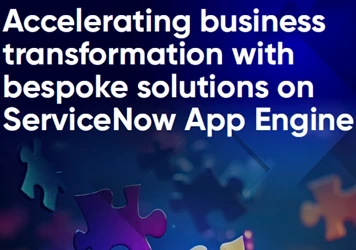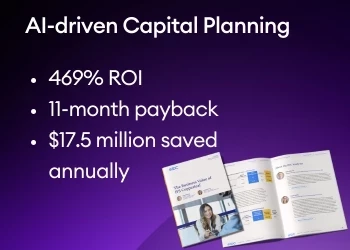How ERP plays key role at professional services industries to boost efficiency
As a growing number of APAC organizations explore the option to implement ERP, PEX Network reveals the results of a wide-ranging industry survey on the technology and offers insight into the true value of ERP from experts at Commonwealth Bank, Bayer, Amiri and Unit4
Add bookmark
Introduction: Bridging the process gaps
An organization that has embraced a model that can manage and integrate all processes into a single system will have a clearer view of its operations than many of their rivals. This model, known universally as enterprise resource planning (ERP), offers organizations the ability to plan and allocate resources to manage their financials, people, projects and planning efforts, ultimately freeing up workforces to do the tasks they were employed to carry out.
ERP implementation bridges the gap between operations and finance, automating day-to-day tasks and bringing together disparate databases so that quick and smart business decisions can be made via data-driven analysis.
In the Asia-Pacific (APAC) region, where the professional services industry continues to grow, many organizations are looking for their employees to be able to focus on their customers and their products rather than on internal processes.
In this report, we hear from ERP experts at Commonwealth Bank, Bayer, Amiri and Unit4 as they review the findings of PEX Network’s ERP’s role in process efficiency at professional services organizations survey which ran in early 2022. They also offer their insight into why organizations in APAC should implement ERP and what the future has in store for ERP innovation.
About the survey
PEX Network’s survey asked 181 professionals working across the APAC region questions about their organization’s approach to ERP implementation and planning. This report dives into those results and focuses on those operating within a ‘focus market’ consisting of Australia, Indonesia, Malaysia, New Zealand and Singapore. Throughout the report, we compare these five markets collectively to the wider APAC market, focusing on the opportunities ERP presents to those operating in these five countries.
Figure 1
In which of the following countries does your organization operate?

Figure 2
In which industry do you operate?

How a holistic solution speeds up decision-making
Finding a fit-for-purpose solution to automate non-value-adding tasks is often overlooked for bigger picture, top-level strategic concerns in many businesses. Having such a solution in place, however, can facilitate ambitious plans by transforming slow operators into fast-moving machines. It can also be the difference between good and bad customer service and, often, the differentiator between profit and loss.
Nao Anthony, senior manager – operational excellence at Australian multinational financial services provider Commonwealth Bank, says: “An ERP is a quintessential step forward toward digital transformation – the primary need that is fulfilled through an ERP is its ability to connect the value chain in an organization.”
As organizations evolve, they do so at different paces, but for enterprise leaders, time is rarely a luxury they are afforded. Nao notes that in today’s business environment, “the demand for value-chain transparency is crucial for both customers and businesses”.
PEX Network’s ERP’s role in process efficiency at professional services organizations survey, reveals that a total of 69 percent of organizations in the APAC region either have an ERP plan in place, are in the process of executing it, or have fully executed it (see Figure 3). This suggests that nearly one in three APAC businesses have yet to implement an ERP plan.
Also read: Market update PEX in APAC
Frederik Skyggebjerg – head of solution consulting for APAC at enterprise software company Unit4, says: “From an enterprise software maturity point of view, if the same survey was conducted in Western Europe or North America, this 69 percent would be higher with one of the reasons being that the services economy is growing faster in the APAC region than anywhere in the rest of the world.”
Skyggebjerg says this factor is among the reasons that Unit4 has established its presence in the APAC region and why it – like many other ERP providers – is continuing to invest widely.
“APAC economies are maturing, and the number of services companies is growing,” he adds. “As they mature, they have to think about their enterprise architecture and how they want to solve business problems.”
“Successful small-to-mid-size companies will not be able to handle their growth by expanding manual processes.”
Harkamal Jit Singh Saini
Director of ERP and IT at Amiri
Figure 3
Does your organization have a strategic vision and plan in place for ERP or digital transformation?

Any business can run without an ERP in place, notes Luiz Barberini, external manufacturing operations manager at pharma and life sciences company Bayer. “Excel worksheets work great,” he notes. “But if you want your company to operate faster, with prompt answers to market needs in a customer-centric manner, you need a good and reliable ERP in place.”
Take action to avoid falling behind
Of the 30 percent who do not currently have a plan or strategic vision to implement ERP in place, just 6 percent say they have no intention of creating one at all. None of these respondents, however, come from our focus market (Australia, Indonesia, Malaysia, New Zealand and Singapore) where a total of 80 percent say they are, at the very least, in the process of building a strategic ERP plan.
Harkamal Jit Singh Saini, director of ERP and IT at luxury fashion brand Amiri, says that avoiding the implementation of ERP can cost a business in multiple ways.
“First, initially successful small-to-mid-size companies will not be able to handle their growth by expanding manual processes,” he starts. “Growth means more data, transactions and reconciliations to finalize profit and loss, and manual processes tend to get more complicated, leading to further chances for error.
“Second, without ERP governance, it is very complicated to keep a business process streamlined,” Saini adds. “In the absence of these flows, a business cannot grow smoothly without investing most of its resources into correcting the process.
“Finally, it is hard to train new team members when everything is managed manually, as it creates huge dependences on team members who own and run processes.”
In the APAC region, Skyggebjerg sees many businesses focus heavily on getting to market and less so on administrative processes, with tasks such as checking and entering data left as manual tasks for workforces.
“I think this approach has held back innovation for some years in this region,” he notes. “But we are seeing salaries increase, high inflation and the cost of cloud solutions lower than ever before – especially in Singapore, Malaysia, Indonesia, Australia and New Zealand – meaning the case for ERP implementation becomes stronger.”
Why breaking down disparate databases can lead to process-orientated results
Figure 4
Which of the following statements best describes how your business currently manages financials, people, projects and planning efforts?

When asked how their businesses manage their financials, people, projects and planning efforts, 19 percent of total respondents to our survey say that they are running disparate databases that require manual processes, such as file transfers (see Figure 4), which have the potential to create further bottlenecks, as organizations follow their impulses to automate. A further 44 percent have some but not all systems and processes integrated and automated, which rises to 58 percent in our focus market.
Commonwealth Bank’s Nao says: “Bringing databases together not only improves data governance but also opens up possibilities to correlate various aspects of organizations’ data to generate real-time proactive intel on businesses, customers, suppliers and correlation.
“The danger lies in missing out on critical intel that could have been pieced together by the combination of databases,” he adds. “Also, data governance and data protection efforts will be non-standard and often manual leading to the potential of data cleansing efforts not taking place due to disparate databases.”
Unit4’s Skyggebjerg says that while he is not against having different databases, if an organization uses a modern cloud solution, it should not be running manual processes between disparate databases.
“The resulting disconnect can account for one of the biggest productivity losses in a business today where it doesn’t think ‘digital-first’,” Skyggebjerg remarks. “We believe that organizations should choose the solutions that fit their businesses best, and this might not always be an ERP or an enterprise solution such as Zoom.”
What Skyggebjerg recommends instead is a modern central platform, which he terms a digital transformational platform.
“Here, you can integrate all your other best-of-breed solutions, meaning you can record your transactions in a safe and efficient way, and you can actually make your core business solution drive digital processes out into your other solutions,” he continues.
On this note, the total number of our survey respondents operating a single integrated ERP/business management platform across all of their businesses in APAC totals just 32 percent. This figure drops to 25 percent for our focus market respondents.
Also read: 4 APAC organizations driving operational excellence
When asked how they would describe their organization’s approach to handling budgeting and forecasting, just 33 percent of total respondents claim they are ‘using a rolling five-year period and data-driven decision-making to forecast next year’s numbers and beyond’ (see Figure 5). This figure rises to 38 percent for our focus market respondents. A small but significant 20 percent say they are working off ‘experience and gut feeling’, while the rest of our respondents say they plan no more than two years in advance.
Putting this into context, Skyggebjerg says that many APAC businesses being targeted for ERP implementation are relatively new in comparison to many organizations in the West, where many heritage businesses think longer-term with contractual obligations set in place for many years and sometimes decades.
“We are entering a maturity stage, however, where many organizations in APAC are either in the market for further investment or are looking to enter the stock market,” Skyggebjerg remarks. “They need to be ready with good process technology, as they do not want to stumble when an investor asks about their five-year plan or forecasted numbers.
Figure 5
Of the following statements, which relates best to the way your organization handles budgeting and forecasting?

Consider the signs and prepare to confront change
Commonwealth Bank’s Nao says that organizations looking for the right time to introduce an ERP should “focus on symptoms” such as customer complaints on lack of transparency and delays or increases in the administrative costs of non-value-adding activities. These activities can include the overuse of paper, mistakes due to human intervention, or the duplication of efforts within value-chain functions.
“The reality is that the cost, time and complexity of an ERP implementation depends on the scale, complexity, and anticipated short- and long-term value by enterprise leaders,” Nao explains. “The disadvantage for those organizations delaying the decision to proceed with an ERP is that they may not reap the full potential of the tools widely used in digital transformation.”
Our survey finds that 34 percent say their consultants and project managers (see Figure 6) report on progress throughout a project via operational project management tools such as MS Projects or JIRA, that integrate into an ERP or finance system. This contrasts with 29 percent who say they use weekly timesheets via tools like Excel (in some cases paper) which are then forwarded onto admins who manually verify and send to finance. This falls to 16 percent in our focus market, with a higher 44 percent reporting on progress throughout a project via operational project management tools.
“The fear we sometimes see from these companies is that they are very used to what they have,” Skyggebjerg remarks. “They might have someone in-house who has developed a platform or customized a solution and that is a very comfortable place to be. But what do you do when this person retires or takes on another job elsewhere? It leaves you in a lot of pain.”
Figure 6
How do your consultants and project managers report on progress throughout a project?

What role ERP plays in aiding businesses to forecast the future

Bayer’s Barberini says, “A good way to predict the future is to better know your past”. This sentiment runs true for organizations with an ERP in place that offers reports featuring accurate data on purchasing and conventional costs. As our survey respondents reveal, more than 50 percent say their teams close off their operational and financial reporting at the end of each month (see Figure 7). Just 24 percent close their reporting off quickly and seamlessly, which falls slightly to 23 percent in our focus market.
Speaking specifically about solutions for professional services organizations, Unit4’s Skyggebjerg says: “With an ERP solution made for services organizations, they can close their periods or month-end results in a matter of hours. If they have a good solution, they could even report on periods or months that are not even closed yet.”
On this point, Commonwealth Bank’s Nao comments: “The stigma that ERPs are better suited to large-scale corporations has been proven wrong as ERP’s value offers are segmented to better suit organizational priorities. The years of US$20–30m investment-driven, multi-year ERP implementations are long gone, with organizations now able to focus on their value processes and start their ERP journeys while adding significant value to stakeholders.”
As all executives know, however, change is the only constant in business. Amiri’s Saini says that an area of constant innovation in ERP lies in its ability to connect seamlessly with different platforms.
“They can process big data sets and automate the reconciliation process for accounts payables and accounts receivable, providing automated solutions for multicurrency, complex taxation requirements,” Saini explains. “The majority of leading ERPs are SaaS-based, providing an opportunity to service providers for constant innovation and updates on different features and modules.
“In order to utilize these features to get efficiency and automation, business leaders must be open to implementing these solutions,” he adds.
In terms of the features most respondents want from an ERP system, more than 60 percent from both our focus market and broader region said flexible customization and fast implementation. Other options such as low total cost of ownership, SaaS or cloud-based features to allow remote access (both 46 percent) and an open platform that allows integration with other systems (44 percent) also score highly among our focus market respondents, suggesting there is no perfect platform and that the market is unable to meet all demands of its customers in one go.
Skyggebjerg says: “Even though we are a specialized ERP solution, and our focus is on one industry, I am not surprised to see survey respondents looking for lots of different features because an ERP solution does many things. It is like the Swiss army knife with many tools. Users are looking for flexible customization and fast implementation, which we have seen in the market for some time, both in the West and throughout APAC.
Figure 8
Do you currently have any plans to improve your ERP/business management system?

Figure 9
Which of the following features would you like to have in an ERP system?

Conclusion: The smart choice for professional services
As revealed in Figure 8 of this report, just 41 percent of respondents to ERP’s role in process efficiency at professional services organizations survey, say they are happy with their current ERP system, suggesting that the majority of ERP users could potentially be in the market for new ERP platforms or solutions.
This report has demonstrated, however, that many organizations value the importance of bringing disparate databases together onto one platform so that they can collate data from different departments and identify a clearer path forward. Successful ERP implementation also helps businesses ramp up their data protection and data governance efforts.
Ultimately, if a professional service organization or any ambitious and fast-growing business in the APAC region wants to truly grasp its potential, ERP implementation can break down internal silos and help it fulfil its potential.
Executives should take a smart and measured approach to ERP implementation and eliminate any chances of harming their current business processes. They must, however, accept change as part of the constant of business and, via ERP implementation, break down the silos that hold talented workforces back from conducting those all-important value-adding tasks.
























